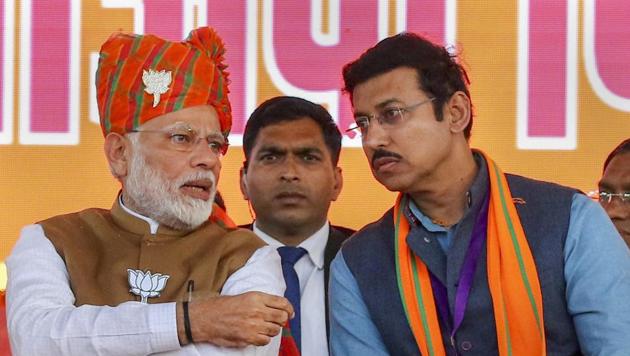Rajasthan Assembly Election 2018: Democratic revenge, reward, and punishment in Pali
Rajasthan assembly election 2018: Local residents did not rule out victories for Congress renegades in Pali and Marwar Junction. If that forecast turns out to be true, there could be a three-way split of the seats up for grabs: two each for the BJP, the Congress and the Independents.
The electoral battle in this textile hub of ‘Marwar’ is a drapery of localised incumbencies, caste intricacies, joblessness and other daily-life hardships. The outcome could well be a jumbled kaleidoscopic image with no one party colour dominating another.

The wave that helped the Bharatiya Janata Party (BJP) sweep the district’s six seats in 2013 isn’t in evidence. On the ground, the voting public’s focus is on constituency-specific choices that are a mix of official nominees, rebels and Independent candidates of whom there seems to be no shortage. There have been revolts in both parties in all the six assembly segments barring Sumerpur: Marwar Junction, Pali, Bali, Jetaran and Sojat.
Local residents with whom this writer spoke did not rule out victories for Congress renegades in Pali and Marwar Junction. If that forecast turns out to be true, there could be a three-way split of the seats up for grabs: two each for the BJP, the Congress and the Independents.
The victorious rebels are expected to return to the parent party if its in a position to form a government. Cited as an example is Bhemji Bhati who’s reported to be doing well on the Pali seat. He spurned the overtures of BJP strongman Bhairon Singh Shekhawat —foregoing thereby a sure-shot ministerial berth— after winning the seat as an Independent in the1993 polls.
The predictions of a fractured outcome in Pali district are based on the perception that the electorate won’t be guided by national-level party mascots holding rallies across the region. The battle isn’t perceived as Narendra Modi versus Rahul Gandhi; it’s between party candidates hamstrung by internal rebellions. The issues being local, the voter’s response will be based on the candidate’s image and track record.
The Congress could have capitalised on the latent anger against Vasundhara Raje by projecting Ashok Gehlot as it’s chief ministerial face. But that hasn’t happened, leaving the field open to intrusions by rebels from influential castes in the division’s 33 seats spread across seven districts: Jodhpur (10), Barmer (7), Sirohi (3), Jaisalmer (2), Pali (6) and Jalore (5).
In the good old days, the Congress, now plagued by rebellions, had leaders who could defuse poll-time intra- and inter-caste conflicts through sage mediation. The trinity that served the party well at the time comprised Rajput leader Khet Singh Rathore, Jat chieftain Paras Ram Maderna and Ram Singh, who was held in high esteem by the Bishnois.
These communities now are politically balkanised for want of a new leadership. Especially after the demise of Shekhawat, the three-time CM, there aren’t any leaders left on either side with a pan-Rajasthan appeal. Their descendants are nuclearised, so are their communities, restricting their rich legacies to tiny constituencies.
Coming back to the contemporary poll, the popular mood for change made chief minister Vasundhara Raje, an erstwhile Maharani, to go around calling herself a servant of the people (sewadarani) in the hope of deflecting anti-incumbency against her regime. Disaffection over ticket-distribution in the Congress might have afforded the BJP some room to manoeuvre. But the CM’s personal appeal stays uninspiring.
Over brunch at Jodhpur’s Sardar Club, a group of influential, well-connected residents agreed that the fight has gotten closer than it was a fortnight ago. However, they remained inclined to wager on a Congress victory, albeit with a reduced margin.
Driving through half-a-dozen seats in Pali and Jodhpur districts, this writer found Gehlot’s acceptance transcending social identities: Jats, Rajputs, Bishnois, minorities and the scheduled castes and tribes. “If he were the CM face, the Congress would’ve struck gold in Jodhpur division,” said Thakur Harishchandra Singh of Pali’s Rohit tehsil. The other drawback he pointed out in the Congress’s bid for power was the Rajputs’ nominal share in ticket distribution: a paltry three in Jodhpur division out of the total of 13 across the state.
In contrast, the BJP has given 30-odd seats to regain the support of the landed community alienated by Raje’s handling of the anti-Padmavat stir and the encounter killing of Anand Pal, a Ravana Rajput strongman. In terms of numbers, the Rajputs balance out the Jats, the other electorally important social group, but are starting to have greater inter-caste acceptability here.
Be that as it may, no community except the Muslims is likely to vote en bloc for any party. The December 7 polling will, in all likelihood, be a blend of democratic revenge, reward and punishment.
Click here for complete coverage of Rajasthan Assembly Election 2018






